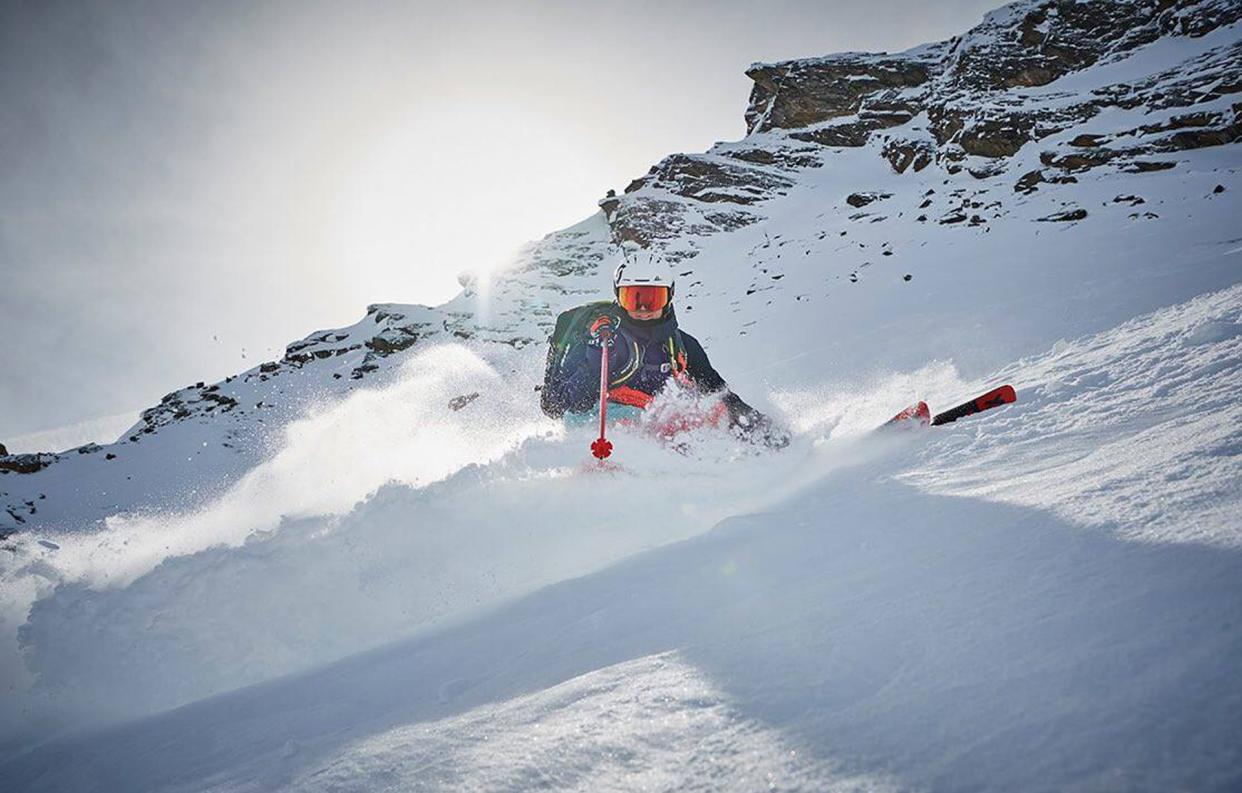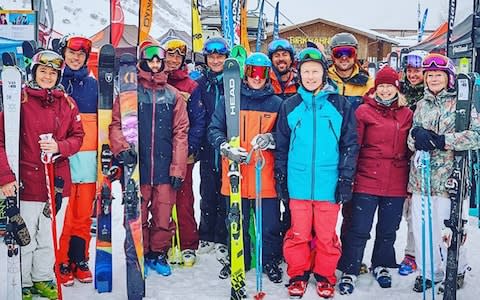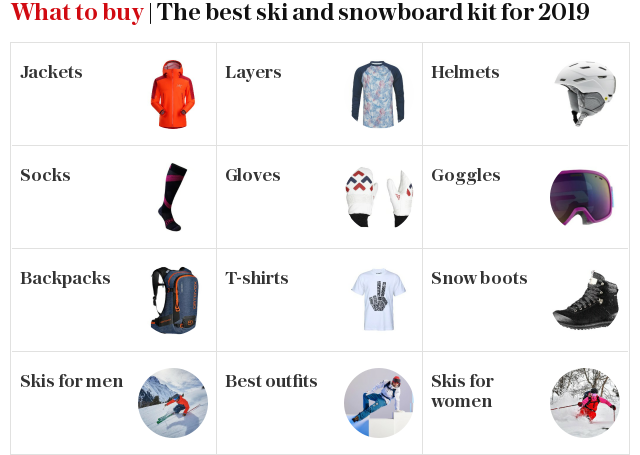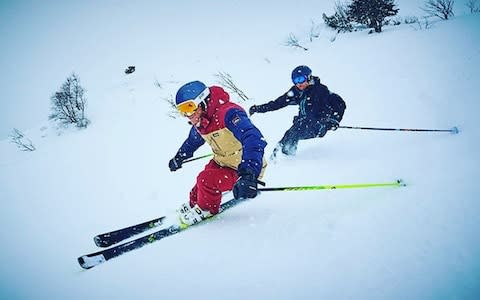A day in the life of a ski tester – is this the greatest job in the world?

It’s Groundhog Day but in the best possible way. Every day for five days I go up the same lifts and down the same combination of runs as many as 15 times, on each occasion with a different set of perfectly tuned next-season demo skis on my feet, ahead of them going on sale to the general skiing public. Welcome to the world of ski testing.
It may be repetitive, but it means I am among the lucky few who get to experience the latest technology that manufacturers introduce to make skis lighter yet stronger say, or easier to turn, with a mission to search out the best.
We also have 2018/19 outerwear, including jackets and pants, to try from Planks Clothing, which was founded in Val d'Isère by British pro skier Jim Adlington, as well as moisture-wicking Odlo baselayers to cope with the hard work we're doing.
The Groundhog Day analogy would be even more relevant if this season's annual Snowsports Industry of Great Britain (SIGB) ski test was in Kühtai, Austria where it was held for the previous six years. Recollections of one year’s test – I’ve been on them all – happily merge into another, since the process of whittling skis down to find the best for our readers is very similar each time.
This year’s new Austrian location, for testing 2018/19 season skis, is Galtür, a 15-minute bus ride from its better-known, and much larger neighbour, Ischgl. This has helped provide a fresh energy for the test and a different backdrop for our photographer to capture ace shots of the team and the skis in action.

Running for 20 years, the SIGB event enables retailers, suppliers and teams from the media to choose test models from 1,055 pairs of demo skis on offer. They’re from big-name brands such as Rossignol, Atomic and Salomon and lesser-known names like Armada, Elan and Faction, with a total of 22 manufacturers represented.
I’m just one member of a 14-strong Telegraph Ski & Snowboard testing crew led by Olympian and Telegraph ski equipment editor Martin Bell. The team includes the likes of his brother, Ski Sunday presenter Graham Bell, top level ski instructors Dougie Mill and Chloe Nicholls, and ski cross competitor Pamela Thorburn. They are gods and goddesses on the slopes who ski with effortless style and flawless technique. I’m on the team, along with journalists Nicky Holford and Cate Langmuir, to give a more regular skiers’ point of view.
On the first night before the test Martin splits us into sub-groups and assigns us the skis we are going to try. For the Telegraph Ski & Snowboard website and magazine we are in pursuit of the best men’s and women’s skis for piste, off piste, all mountain and park and pipe. For testing, most of these categories are further split into advanced, intermediate and expert skis with 10 to 20 models in each. We let the suppliers decide which of their skis we’ll test in each category.
Quick look at the #skitest18 site in #Galtur. ⛷⛷ @planksclothing @odlo #skiing #skis #snowsports
A post shared by Telegraph Ski and Snowboard (@telegraphskisnowboard) on Mar 5, 2018 at 3:03am PST
This means that, between us, we test more than 200 pairs of skis to determine the very best to share with our readers. My first category of skis to test was all-mountain advanced - these are designed for 50/50 on- and off-piste use, from hardpack to deep pow. It’s a big category, and this season there were 19 models on my list.
As we're staying in a Ski Total chalet in Ischgl, each day begins with a bus ride to Galtür and its compact Silvapark ski area, which has eight lifts and elevation from 1,600m to 2,300m. With so many skis to test in a relatively short period of time, we're always up early on one of the buses that departs before 8.30am and gets us to the site before it officially opens at 9am - then it’s time to test.

Each day, I choose a ski from my list and head up the first and second chairlifts. On that first day I did a quick run from the top of the lift to scope out a route and was happy to see there’s a good combination of rolling red and black pistes, plus ungroomed areas off to the sides, to give the skis a really varied all-mountain run back to base and the makeshift test centre, where all the ski suppliers with their colourful collections of skis are based.
For each category of skis I'm testing, I ski my chosen route three times on a different set of skis for each run, making sure to take exactly the same route every time to give a fair comparison and get a good idea of the differences between them. On each run I do short turns, long turns, ski at pace, at slower speeds, in moguls and a section off piste.

All the time I mentally score how they perform, and think about whether there is anything that really stands out, waxing lyrical in my head about how they perfectly slice and dice the piste, float angelically and easily through powder or make mincemeat of cruddy snow.
Yes - I am enjoying myself! But it's also important to assess how the skis perform in their category and not just ski how I like to. Are intermediate skis sufficiently easy to turn or too stiff? Are some skis in the piste category maybe a touch too off-piste orientated? Whatever pair of skis I'm on though, it's a great privilege to get first dibs on new-season tech in box-fresh condition, and to be able to make a mental note of models I might personally like to seek out next winter. Or pick as my ski of the day - we send out regular #SkiTest18 video reports via Facebook and Instagram during the test.

After three runs I stop for 15 minutes at the base to fill out test cards and record the scores I’ve mentally made in each criteria. As well as short and long turns, fast and slow speed, bumps and off piste, I also need to score them for liveliness, responsiveness, versatility, overall performance and performance within category. Scoring can be tough, as generally all the skis we test are good, but they have different plus points.
There’s a space for comments where I write a couple of sentences to describe further how I feel about the skis such as, “You have to work the skis hard but it’s worth the effort as they give a lot back. Great for someone looking to push themselves.” Then I push on with the next three skis in the category.
Each time I complete a run I go to a different supplier and hope the skis I need will be available, not being tested by someone else. The brand reps ask for my boot length and DIN setting before adjusting the bindings to fit, then after I've clicked the technician makes further minor adjustments and inevitably gives me details about the construction and unique selling points of the skis I’m about to test. The process takes a matter of minutes – it’s like a Formula One pit stop on skis.
Apart from changing skis the only other rest times are for a coffee or a packed lunch at the base with my fellow testers. With so many models to test there is no time to waste.
By 4pm on the first day, when the lifts shut I’d tested 12 pairs. Not as many as I wanted but with another four days to go, there were lots of chances to boost the daily average. And no chance of wasting time getting lost.

